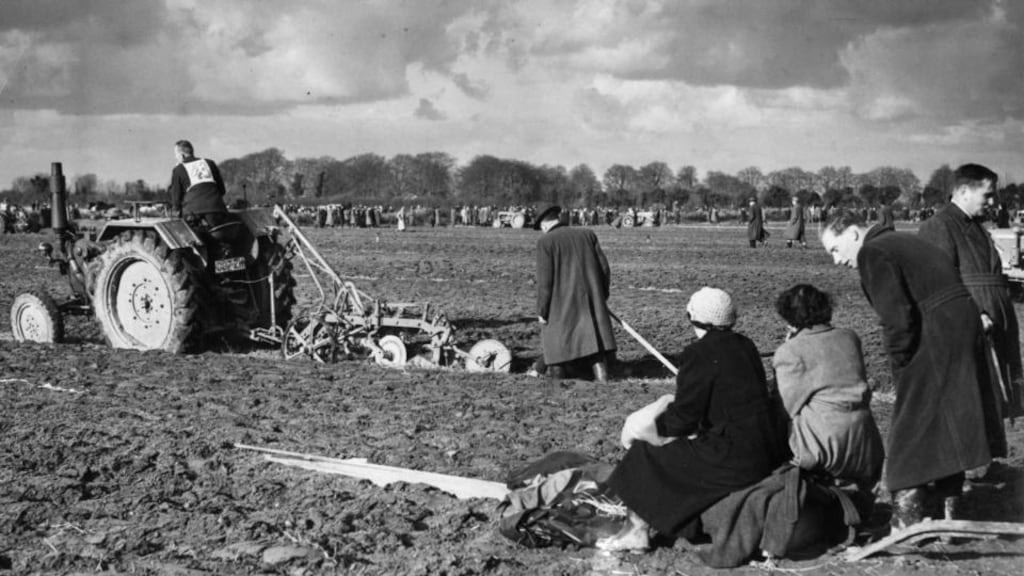This is the month when the earth moves in rural Ireland, as tens of thousands of people go to the National Ploughing Championships to relax and celebrate the end of the farming year. To those who attend no explanation is necessary; to those who do not, explanation is virtually impossible. Suffice to say, your education is incomplete unless you have been to one of these gatherings.
The scale of the event is the first thing to strike the visitor. Hundreds of acres of tents, stalls, carparks and ploughing plots mushroom out of ground for the championships which attracts up to 200,000 people over the three days.
Diversity
And while this is primarily a farming event, over the years it has become a truly national event for urban and rural people, the young and the old and for hundreds who come from overseas to take part.
Diversity is the name of the game and on site you will be able to purchase anything from a facial massage to a €200,000 earth-moving machine. You will run into sporting celebrities and entertainment stars, the country’s top models, musicians and media names.
You can watch fashion shows or vintage trashing. You can hear some of the finest bands in the country, see the top ploughmen and women strut their skills and it will be impossible to leave the site without having your hand shaken by at least one politician, but more of that later.
It is astonishing to recall the championships began as the result of an argument between a Kildare man, JJ Bergin, and a Wexford man, Denis Allen, about which county produced the best ploughmen. They decided to settle the issue by holding an intercounty ploughing challenge and then, back in 1931, the first seeds of the National Ploughing Championships were born in Athy.
In the following years, tractors replaced horses as the main tillers of the earth and the numbers attending the annual event grew steadily.
However, the real breakthrough came when the championships were extended to cover three days, rather than two, and the event was held for three years running in Oak Park in Carlow. The network of surrounding roads, the proximity of rail and bus services and the dryness of the site which had many tarmac and concrete roads running through it made a huge difference.
Mulch
Before then, because the event normally took place on sites with few roads and pathways were generally made up of mulch which became mud even when there was little rain, the championships fell into three different classes. You had wellington championships, waders championships and wetsuit championships depending on rainfall levels.
In those years, urban Ireland began to discover “the Ploughing” and business began to get involved in a deeper way. The politicians realised there was a readymade hustings available if they got into their Mercs and came down the country.
Traditionally, the championships have been officially opened by the president and successive holders of the highest office in the land going back to Seán T O’Kelly have done the honours. Ministers for agriculture down the years also made the trip but since the Carlow championships, serving taoisigh, opposition leaders and any politician worth his salt, went ploughing.
The arrival of the politicians seemed to follow a growth in the media interest in the event. In the Carlow days, there would be a single representative from the national newspapers and from RTÉ. Now there are over 100 credited media personnel at any of the championships and live broadcasts are made from there by national and local radio and TV stations.
Political parties
All the political parties have their own special tents, cheek to jowl with churches, charitable organisations, sellers of nick-nacks, cars, electrical equipment and crafts. For a time, during the Celtic Tiger, there was even a tent where you could go to learn how to lay stocks and shares.
Perhaps the best thing that happened to the NPA following the Carlow boost, was the first Iraq War. Following the 1991 war, the US and its allies sold off the surplus steel trackway they had used to land aircraft and help tanks move over the desert. It was available for hire from the 1992 onwards and put the event on a much firmer footing when it was imported here to be laid down on the sites. Nevertheless, I remember being towed on to the site in Clonmel in 1993 and two years later, being unable to find my car for nearly two days when I parked it in Ballacolla, Co Laois.
Hosting this spectacular event requires not just hundreds of acres but also an army of volunteers. The ploughing competitions are held on special plots removed from the central exhibition area and there over 300 competitors will be showing off their skills.
It can legitimately claim to be one of the largest outdoor events in Europe and has been described as a fleadh cheoil without the music, or an all Ireland final without the ball.
In terms of a national event, it dwarfs everything. Hurling and football finals, Croke Patrick, even St Patrick’s Day parades are only in the halfpenny place when it comes to “the Ploughing” .









